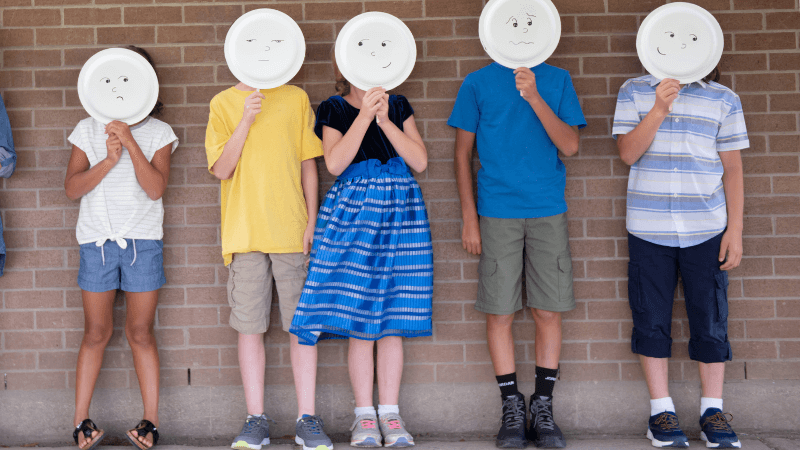
How Big Emotions Affect the Classroom
The list of emotions that may be present in the classroom runs long, and emotions can come on strong, making it difficult for students to think clearly or respond skillfully. This is especially true when it comes to anger, fear, or overwhelm. Students often have strong visceral experiences of these emotions—their hands can get clammy, their heartbeat can quicken, their body can feel achy, and they might sense heat rising in their body. All of these can make it extremely hard to think and focus during class.
Helping students pause and notice the sensations in their body and then reorient their attention supports emotional regulation. When they pause, they can discover what supports them to settle and create enough space to manage the emotions and sensations they’re experiencing. With practice, the pause gives them the choice to respond to the situation rather than just react.
Try This 4,3,2,1 Lesson
Try this 4,3,2,1 strategy to help your students navigate strong emotions. In this activity students use their senses of sight, hearing, and touch as well as their breath to shift their attention, and ease any sense of overwhelm they might be feeling.
Invite them to follow along as you guide them through the 4,3,2,1 Practice:
FOUR: See if you can find four blue or green objects in the space around you. Each time you find one, take a deep breath in and out. {Pause to allow time for students to look around them, encouraging them to look behind them, too. Reorienting their focus outward, and away from their internal sense of dysregulation, helps them settle, and blue and green in particular are considered soothing colors.}
THREE: Now see if you can shift to noticing three sounds outside of our classroom. Perhaps you notice kids talking in the hall, or birds chirping, or the wind blowing? Each time you notice a sound, take another deep breath in and out. {Pause to allow time for students to listen}.
TWO: Now see if you can notice two sounds inside this room, taking another deep breath each time. Do you hear any sounds that you hadn’t before?
ONE: Finally, you can place one hand on your chest or your belly. Can you feel your heartbeat, or your chest or belly moving as you breathe?
After completing the activity, you can ask students the following questions:
What sensations do you notice in your body now? You might prompt them with additional suggestions such as:
- Are your palms sweaty?
- What’s going on with your breathing right now – is it slower, faster, or the same as before? slowed, or increased?
- What about your heartbeat? Has it sped up or evened out?
Does anyone still notice strong sensations in their body? If yes, let students know that’s totally normal, and invite them to repeat the exercise until they feel ready to move on.
With continued practice, mindfulness exercises can support students to build greater awareness of themselves and empower them to change their internal patterns and behaviors, including their judgments, biases, and stress responses.
Anytime throughout the day, when students notice a strong emotion taking hold in their mind and body, they can use 4,3,2,1 to take a pause.
Remind students to be gentle with themselves––having big emotions is part of the human experience and it’s not easy to pause. Celebrate your students for experiencing, noticing, and navigating challenging experiences.
Educators, Explore Mindfulness in our 101 Course
In 101: Mindfulness Foundations, learn practices that can resource you during the school day and daily life, with trauma-sensitive approaches for navigating emotons, working with thoughts and biases, and cultivating compassion and joy. Educators earn credits.
Bring Mindfulness to Your Classroom
In 201: Mindfulness in the Classroom, learn trauma-sensitive strategies to nurture social and emotional well-being in your classroom. Access the Mindful Schools K-12 Curriculum and Teaching Kit. Educators earn credits.
What Is Mindfulness?
Mindful Schools defines mindfulness as being present here and now, paying attention to thoughts, bodily sensations, emotions, and the external environment with kindness, nonjudgment, and curiosity.
Mindfulness is a practice that can provide immediate tools to meet the difficulties of life with care and compassion. With continued practice, mindfulness can support us to do the personal work of changing our internal patterns and behaviors, including our judgments, biases, and stress responses. When our awareness of our internal world starts to change, our relationship to what is happening in the external world can change.
A common myth of mindfulness: “Mindfulness can be introduced as a classroom management or behavior management strategy, or a way to support compliance; students will be still, quiet, and calm during mindfulness lessons.”
On the contrary, mindfulness teaches students to be aware of all experiences, including when they’re loud, restless, or active. It is offered without expectations, as an invitation for self-awareness. Mindful Schools programs provide trauma-sensitive strategies and a range of options for students to engage in mindfulness practice. Students are in choice about how, and if, they practice mindfulness.

UPCOMING WORKSHOP:
Mindful Games for your Classroom
Wednesday, April 24, 2024 at 4pm ET
Join us for this dynamic 90-minute training to experience mindfulness through play to evoke curiosity, spark creativity, foster engagement, and support learning.



